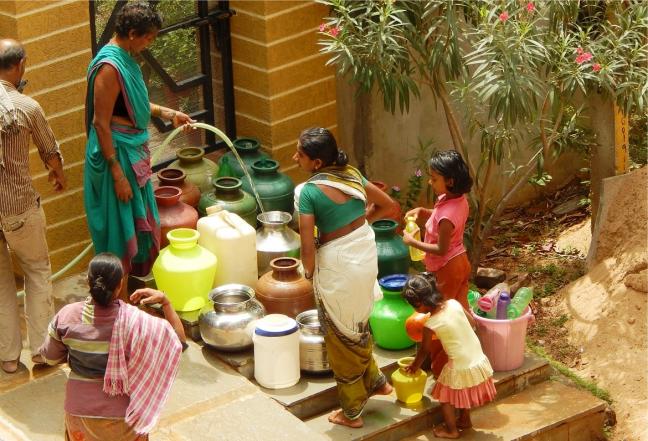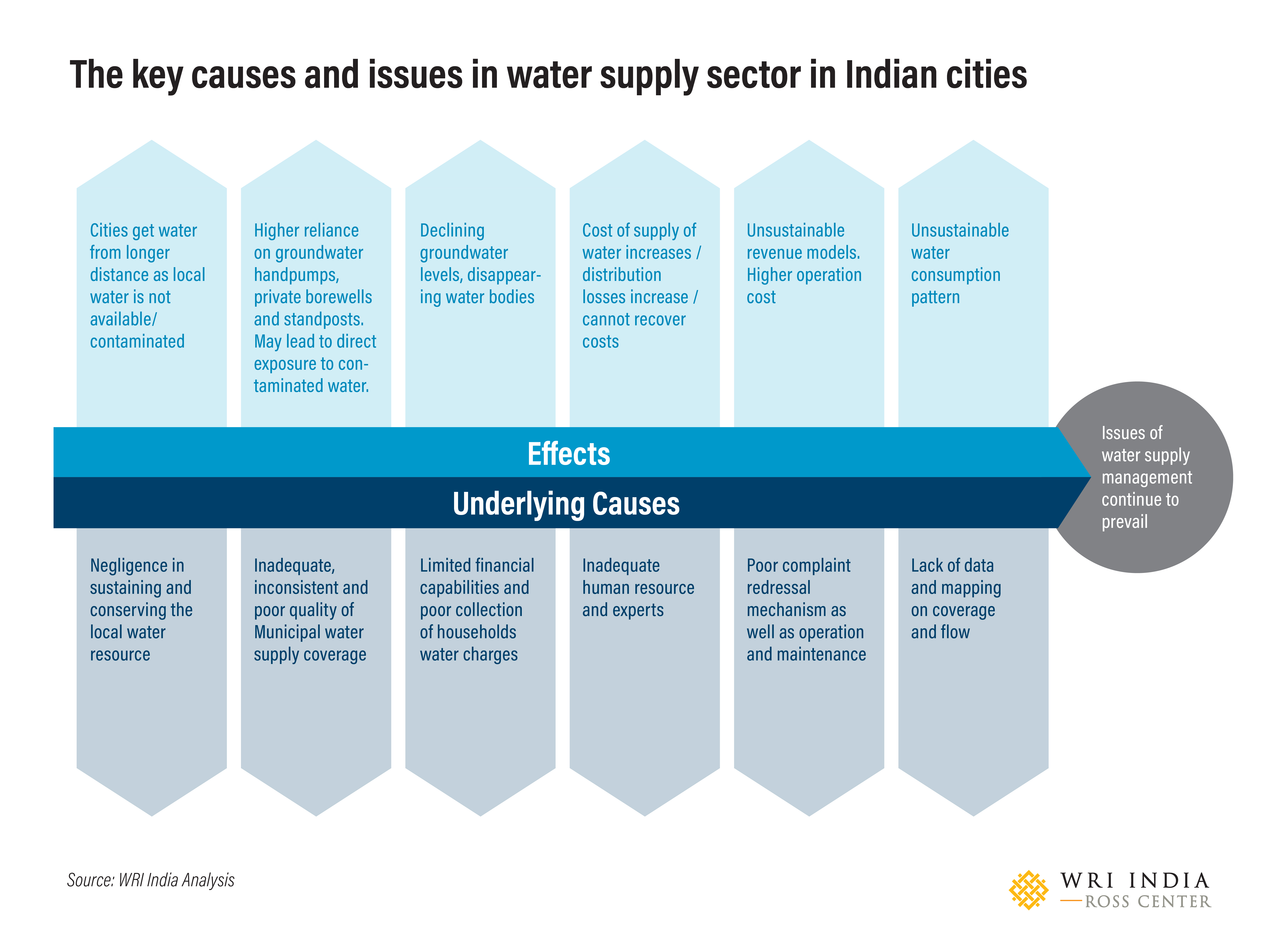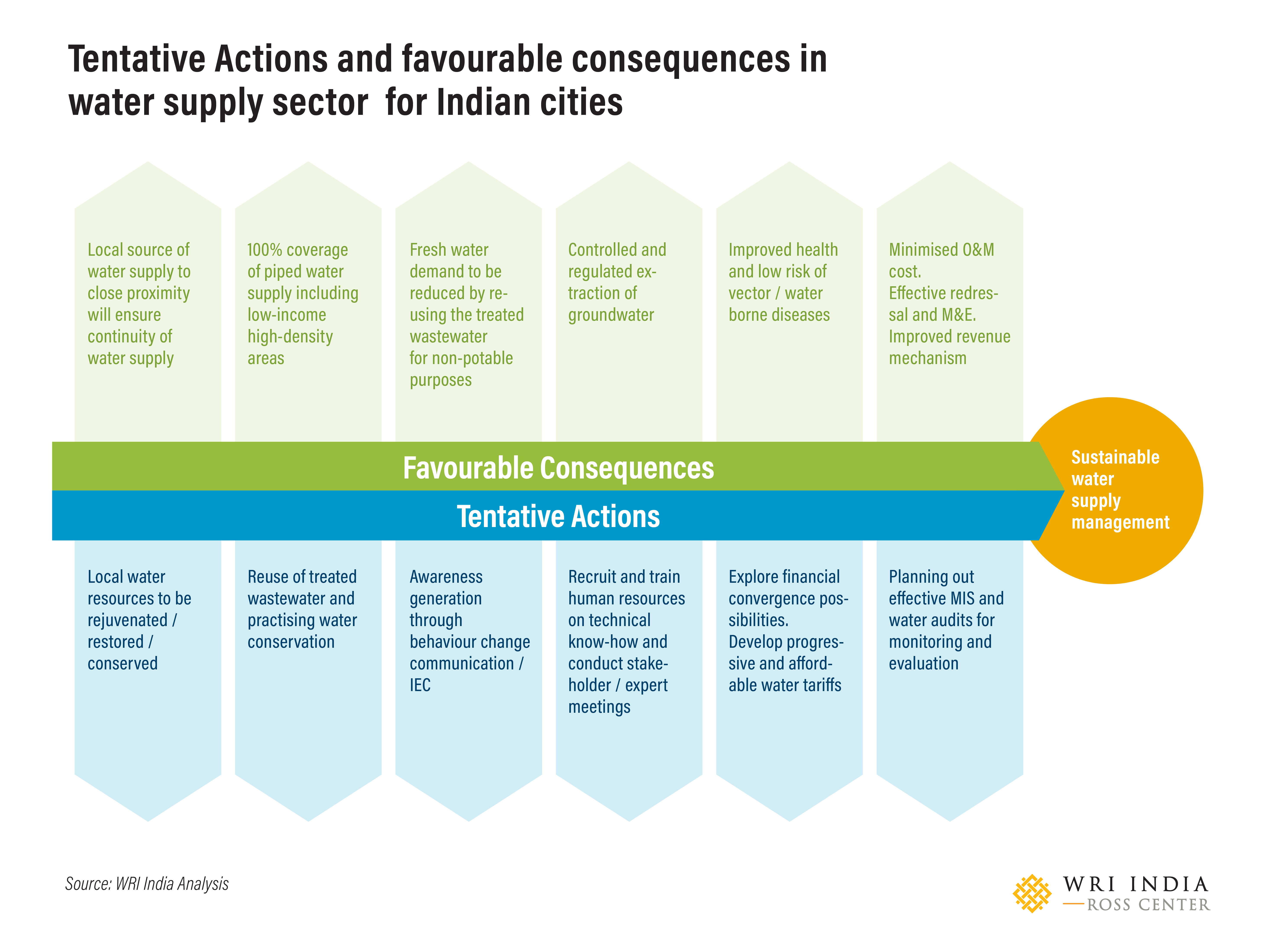Parched Cities of India: Jal Jeevan Mission as a Ray of Hope for Urban Water Resilience
by e -
This article first appeared in the Georgetown Journal of International Affairs on April 23, 2021.
Persistent issues in urban India’s water infrastructure have necessitated the rollout of the Jal Jeevan Mission (JJM-U), a comprehensive and holistic approach to achieve a water-resilient future for India.
Rapid urbanization in India poses extreme water risks, including scarcity and pollution, creating obstacles for urban utilities to provide adequate clean water for all. The United Nations’ Sustainable Development Goals (SDG) offer a framework linking equitable development and poverty reduction to urbanization, access to safe water and sanitation, and climate action, among other priorities (SDG 6, 11, 13). Achieving the SDGs can help India meet its urban water demand, strengthen urban resilience, and mitigate the impacts of unplanned urbanization and climate change. India’s new Jal Jeevan Mission (JJM-U) serves as a progressive water conservation program that identifies key areas of concern, shifts away from inefficient traditional methods, and leverages local water resources. While the JJM-U is set to bring about a paradigm shift, it needs to adapt its interventions to different local contexts by outsourcing information, conducting data analysis, and creating a specialized task force.
Issues of Existing Water Supply Systems in Urban India
According to the National Family Health Survey (2015-16), thirty-one percent of Indian urban households lacked access to piped or public tap water. This percentage has remained unchanged as services have not kept pace with rapid urbanization, especially hurting low-income settlements. With unreliable water supplies, households may adopt coping strategies to meet water needs that often result in unregulated groundwater extraction, such as through private wells or water tankers. Unplanned extraction results in the exponential decline of the groundwater table, as water is consumed faster than it is replenished in high-density urban areas.
Another issue is the inefficiency in service delivery due to lack of maintenance of the water supply distribution system. With insufficient capacity to manage local water resources, Indian cities follow the conventional “supply-side water approach” by estimating the demand for water and implementing projects accordingly. However, due to the depletion of local water resources, water sources have retreated, ranging between 50 and 200 kilometers, making water systems more prone to leakage. The average Non-Revenue Water (NRW) refers to the amount of water lost before it reaches consumers due to poor infrastructure. In India, the average NRW ranges from thirty to forty percent in large cities, and forty to fifty percent in smaller cities, highlighting significant distributional losses of water.
Officials face major costs to combat these two major issues, however. The treatment of polluted water resources, longer pipelines for distant water, and high energy consumption to pump and distribute water are expensive to invest in and maintain. Moreover, when it comes to cost recovery, city water utilities face severe financial stress not only with the amount of NRW, but also with low and inconsistent water charges and poor recovery of water bills. Hence, it is difficult to devise cost-efficient and sustainable solutions to attract private investment while exploring schemes to enhance piped water supply coverage.
The Composite Water Management Index (CWMI) report by the NITI Aayog in 2018 further emphasizes the needs of India’s water supply systems. In addition to previously highlighted issues, the report identified two key reasons that Indian cities might reach “Day Zero,” in which residents will face an acute water shortage: negligence toward climate change’s impacts and existing local water resources like groundwater, lakes, and wetlands. An approach that considers these factors to mitigate India’s urban water risks is long overdue.

Launch of Jal Jeevan Mission Urban (JJM-U)
The launch of JJM-U by the Ministry of Housing and Urban Affairs (MoHUA) under the Indian government provides hope for improved water infrastructure by allocating a total of $40 billion for 4,378 statutory towns. The mission brings about a transformative shift from traditional linear water supply delivery to a model that encompasses a circular economy of water conservation. This model is in line with the Five “R”s approach to water management—reduce, reuse, recycle, restore, and recharge—and considers the entire water value chain, from the supply to consumers to the disposal of used water.
Unlike past efforts, the JJM-U also recognizes the importance of developing a comprehensive baseline and holistic plan prior to the identification and implementation of projects. The JJM-U prioritizes the development of three plans: the City Water Balance Plan, the City Used Water/Recycle/Reuse Plan, and the City Aquifer Management Plan.
The plans emphasize that the first step for cities should be mapping out all water connections and conducting an audit of the entire water supply infrastructure to identify the key areas of concern.
The second step of the JJM-U not only focuses on urban aquifer and groundwater conservation, but also emphasizes the overall city water balance and rejuvenation of local resources like lakes and wells. It addresses accessibility, recycle-reuse methods, and controlled extraction while developing a strong framework for evaluating maintenance and financial sustainability. Most importantly, MoHUA has finally recognized the relationship between water supply and wastewater management, garnering initiatives to keep existing water resources pollution-free and reduce the freshwater demand. For instance, to replace an expected twenty percent of total water demand and forty percent of industrial and other non-potable water demand with recycled used water, nature-based decentralized solutions are encouraged; thus, the JJM-U promotes the reuse of water close to the source and the user.

While the JJM-U targets many key urban water issues, the initiative needs to consider further societal integration for sustainable water management. For example, apart from reducing the leakage losses or the NRW, conservation practices must be promoted at the user or consumption level through Information, Education, and Communication (IEC). IEC can encourage local practices including the use of water-efficient fixtures, sustainable landscaping, localized rainwater harvesting, and recycle-reuse of wastewater to further conserve and manage water.
In order to achieve these water efficiency goals, cities must follow Best Management Practices, such as those that comply with the Transparency, Accountability, Public Participation, and Capacity (TAP-C) framework. Maximizing transparency in the water sector requires the generation of freely accessible, high-quality data and information that is understandable and usable. This will further help water utilities provision with reduced risk of corruption and will make basic service delivery more effective.
Considerations Moving Forward
Water is not an infinite resource. Instead of following the set practice of projecting general water requirements, governments should formulate water plans with the local context in mind. For instance, plans can be supported with spatial data analysis reflecting characteristics of peri-urbanization, low-income neighborhoods, recharge potential zones, and high-density areas in the city. This data will enable urban local bodies to undertake effective and targeted interventions to improve access, manage demand, and protect the natural infrastructure of water.
The associated risk of climate change-driven, extreme weather conditions must also be considered. Climate risk mitigation goes hand-in-hand with developing sustainable financing mechanisms with different private partnership models. Models must identify service levels needed, willingness to pay, and affordability for the urban poor along with rationalizing the water pricing for bulk consumers and improving the efficiency of revenue collection. The implementation of such a comprehensive scheme will require participation and advisory from multi-sectoral experts. Therefore, a setup of a dedicated task force for stakeholder engagement will be an important step towards forming water resilient cities.
While the JJM-U still has room for growth, the initiative deserves credit. It allows experts to access data, study structural constraints and identify potential solutions. The transformative shift from past efforts may bring a ray of hope for India’s urban water challenges.
Views expressed are the authors’ own.


